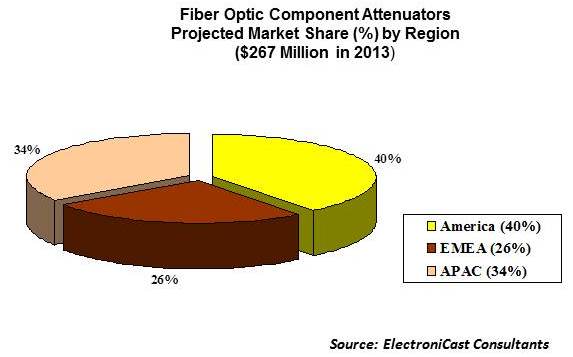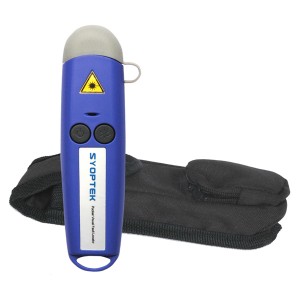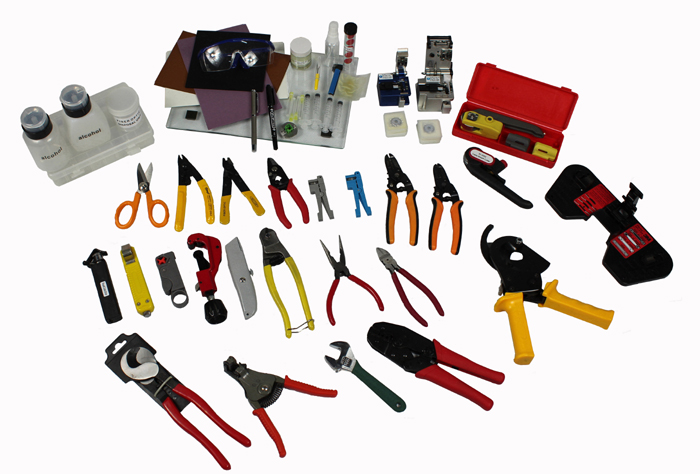
Fiber optics is full of jargon but it’s important to understand it. One of the more confusing terms to many is “wavelength.” It sounds very scientific, but it is simply the term used to define what we think of as the color of light.
Light is part of the “electromagnetic spectrum” that also includes x-rays, ultraviolet radiation, microwaves, fiber optic cleaning, radio, TV, cell phones, and all the other wireless signals. They are simply electromagnetic radiation of different wavelengths. We refer to the range of wavelengths of electromagnetic radiation as a spectrum.
Wavelength and frequency are related, so some radiation is identified by its wavelength while others are referred to by their frequency. For the radiation of shorter wavelengths, one click cleaner, light, UV and x-rays, for example, we generally refer to their wavelength to identify them, while the longer wavelengths like radio, TV and microwaves, we refer to by their frequency. wavelength
Archive for May 2013
The Wavelengths Used In Fiber Optics
Datacom market flew in 2013
Market research firm LightCounting says the market for optical components and modules posted 9% growth for the year with total sales exceeding $4.2 billion. The company projects a similar growth rate for the total market in 2014, but says the growing top-line numbers hide a lot of volatility.
Some market segments almost doubled in 2013, while others declined by a third. Growth in annual sales of datacom optical products accelerated, reaching 20% in 2013, compared to 16% in 2012. However, the telecom optical components and modules market remains dormant, fiber optic cleaning advancing by just 3% in both 2013 and 2012.
“It is possible that the telecom market will have a better year in 2014,” the company said in a statement. “LightCounting data suggests that the datacom market responds faster to changes in economic outlook than the telecom industry, which could lag a recovery by three-to-five quarters.”
The data were released as a preview to LightCounting’s “January 2014 Market Forecast Database.”
Sales of Ethernet optical transceivers were up 37% in 2013, exceeding $1.3 billion, and will remain the largest market segment in 2014, although the growth rate is expected to moderate. Shipments of 100 Gigabit Ethernet modules will continue to ramp upwards in 2014, one click cleaner but growth in revenues will be modest, as competition among suppliers will push prices down. Read more
Fiber-optic attenuator market worth $370M in 2018
According to the latest report from ElectroniCast Consultants, the use of component-level fiber-optic attenuators will reach $370 million in 2018. Attenuators are used to control the power level of an optical signal used in fiber-optic networks.
“Dense wavelength-division multiplexing [DWDM] is widely used to expand the capacity of optical communication networks,” explained Jeff D. Montgomery, chairman of ElectroniCast. “DWDM employs multiple wavelengths and channels in different communication protocols and bit rates requiring precise tuning of the power levels of the channel signals; otherwise, some channels may be distorted. Fiber-optic attenuators are often used to adjust the optical signal strength before they reach an optical device.”
SYOPTEK's Quality and Reliable Fiber Optic Test Equipment
SYOPTEK designs and manufactures fiber optic test equipment for optical fiber cabling installing, maintenance, and verification; provides you quality, reliable fiber optic test equipment at a affordable price.
SYOPTEK fiber optic test equipment line includes Fiber Optic Inspection Probe, Fiber Optic Inspection Microscope, Optical Light Source, Optical Power Meter, Optical Fiber Identifier, Fusion Splicer, and Visual Fault Locator.
Optical network trends for 2013
These overarching themes will keep evolving in 2013. As the world becomes increasingly connected and mobile, all of the tech companies that touch the network are pushed to find new ways to remain relevant to survive. They must continue honing their business models and operations for maximum efficiency in an unpredictable economic environment. They must continue building out faster and more flexible networks to support increasing and more random traffic patterns. And they must continue to create innovative products and services that support our need for instant access via new apps and the next shiny and new connected device that captivates us based on increasingly shorter product cycles.
This is not breaking news, but themes that will intensify throughout 2013. Here’s a look at how these themes will play out in various aspects of optical networking. Read more
SYOPTEK's High Quality Tools for Fiber Optic Industry
SYOPTEK provides the high quality tools for the fiber optic industry, SYOPTEK fiber tools prepare the fiber for installation, splicing, and termination with clean and accurate stripes and wraps.
The SYOPTEK fiber tools line includes: fiber optic strippers, fiber optic cutters & scissors, fiber optic cleavers and blades, fiber cable slitters, fiber crimp tool, dispensing bottle.
Optical network system market worth more than $17.5 billion in 2018
Annual spending on optical network (ON) hardware will surpass $17.5 billion by 2018, according to analyst firm Ovum. The popularity of 100-Gbps technology will drive what would amount to a 3.1% compound annual growth rate (CAGR) from 2012, notes Ovum. Increased sales of submarine line terminal equipment (SLTE) also will contribute to the positive momentum.
Ovum made the prediction on the heels of what the market research firm described as “an exceptionally strong” second quarter of 2013 (see “Optical hardware sales resume growth says Ovum”), which Ovum analysts believe signals the beginning of a rebound in spending. The quarter was the strongest in the last six and was the seventh highest quarter in the last 10 years, Ovum reports.
“Ovum’s 9.1% growth projection for North American ON sales in 2013 signals a solid bounce-back year after two years of non-growth,” says Ian Redpath, analyst, network infrastructure and author of Ovum’s new “ON Forecast Report: 2012–18.”
“Network core investments are resuming and 100G is being deployed in volumes,” Redpath continues. “The North American Tier 1 communications service providers (CSPs) and cable operators are investing in their core network to support all traffic types.”
Elsewhere around the world, Ovum expects spending growth in the Asia-Pacific and South and Central America regions. Ovum anticipates growth in Asia-Pacific ON hardware spending to reach 3.1% this year, with strong growth in China, with help from the ASEAN-5 countries (Indonesia, Malaysia, Philippines, Thailand, and Vietnam) and Australia and New Zealand (ANZ) offsetting projected market declines in Japan and India.
South & Central America ON spending is projected to grow by 1.6% this year. The market in this region as surpassed the $1 billion mark, a level that Ovum expects will be maintained.
However, Ovum doesn’t expect growth everywhere. The Europe, Middle East, and Africa (EMEA) region will remain in the economic doldrums this year, the market research firm believes. “We expect 2013 ON sales to come in at a dismal negative 9.6% versus the 2012 level,” explains Redpath. “Spending has been down in four of the past five years, and under-investment in the region is becoming more acute. At some point, the CSPs will have to resume buying to make up for this prolonged period of under-spending.”
EMEA’s drag on growth means that, overall, ON spending globally should only growth 1.1% in 2013 versus 2012, Ovum predicts. But it’s a place to start.
“Ovum’s most likely forecast scenario to 2018 projects strong positive growth in North America. Modest growth is projected for Asia-Pacific as a whole, with strong growth for ASEAN-5 and ANZ, moderate growth for China, and low growth for Japan and India,” Redpath says. “The growth expectations for Europe are a mixed: down in 2013, modestly positive in 2014, and then more vigorous gains for 2015 and beyond.”
The popularity of 100G technology will remain strong over the entire forecast period, starting this year. Revenues for 100G system surpassed 40G sales for the first time in 2Q13, growing 233% during the first half of the year compared to the year-ago six months to reach 1 billion. Meanwhile, 40G sales are headed in the opposite direction, shrinking 24% for 1H13 and dropping below $1 billion to $942 million.
“Nearly all new large-scale, long-haul optical networks designed and deployed today will be 100G. 100G has assumed the lead position and will not yield within our forecast period,” predicts Redpath. “Two positive market trends are emerging at the same time. The first is a need for the CSPs to refresh network technology after a long period of running core networks hotter and delaying investment. The second major trend is the maturity of 100G technology to the point where CSPs have begun deployments at scale. 100G is in the right spot at the right time.”
Introduction To One Click Cleaner
The One Click Cleaner is an easy-to-use option for cleaning connectors in adapters. Simply insert the One Click Cleaner into an adapter and push until an audible “click” is heard. The One Click Cleaner uses the mechanical push action to advance an optical grade cleaning tape while the cleaning tip is rotated to ensure the fiber end-face is effectively, but gently, cleaned.
The One Click Cleaner is a must-have for field technicians. Small enough to fit in a shirt pocket and a great addition to cleaning kits.
Report: Data center infrastructure market to exceed $15B by 2014
n a new report, IMS Research forecasts that the market for power and cooling products supporting data centers will be worth more than $15 billion by 2014. The report, entitled Data Center Infrastructure Yearbook, shows that the market will grow modestly over the near-term, from approximately $13 billion in 2011.
The study quantifies the market for uninterruptible power supplies (UPS), floor and cabinet-level power distribution, racks and enclosures, and cooling products. The analysis found that UPS is by far the largest market, worth more than $8 billion in 2011.
Jason dePreaux, associate director with IMS Research, says that growth in the data center infrastructure market is a balance between opposing forces. “Digitization continues unabated,” he adds. “Mobile data, electronic health records, and richer Internet connectivity drive data processing and storage needs which, in turn, requires more data centers. At the same time, new server generations offer greater performance per watt, which somewhat mitigates the need for additional critical infrastructure.”
dePreaux believes that economic conditions often play the role of tiebreaker. “The cloudy economic picture severely dampens companies’ willingness to spend on capital-intensive projects like data centers,” he warns.
The new report forecasts the highest growth for products that are used to help improve efficiency in data centers. For example, IMS found that the need to more closely monitor electricity use is reshaping the power distribution market, with intelligent hardware which commands higher prices than their “dumb” counterparts. Cooling equipment is also changing to cope with high-density computing environments. Even enclosures are changing to better facilitate increased airflow and power cabling, notes the study.
Further, over the past five years, three vendors have consolidated their positions in the market via acquisition. The report found that Schneider Electric, Emerson and Eaton combined to hold 47 percent of the total data center infrastructure market last year.
“The big three have each made multiple acquisitions to enhance product portfolios and extend geographic reach,” concludes dePreaux. “Beyond this are literally hundreds of vendors that have carved out smaller niches around the world.”
Related:fusion splicer visual fault locator
This article is from the network
Data center census: Investment growing 22 percent this year
A global data center census conducted by DCD Intelligence (DatacenterDynamics Intelligence) found that worldwide investment in data centers is growing from approximately US$86 billion in 2011 to $105 billion this year. The census is described by DCD Intelligence as “the largest worldwide quantitative survey of the data center industry.” DCD Intelligence managing director Nicola Hayes commented, “Our forecast for 2013 shows a slower rate of growth but still a very healthy 14.5 percent over 2012 levels, with a further $15 billion of additional investment.”
The survey incorporated systems across data centers, including facilities management, mechanical and electrical systems including power supply and cooling, as well as IT equipment. That sector includes active equipment such as servers, storage, switches and routers, and showed 16.7-percent growth – from $30 billion to $35 billion – in the current year, with a 12-percent growth rate forecast for 2013.
Of data centers overall, Hayes said, “Much of the increase in investment in this sector is being driven by growth in less-developed markets, although we continue to see some growth in the mature data center markets of North America and Western Europe. Regions such as Asia Pacific and Latin America are the ones really fueling global data center investment levels.”
Perhaps the most eye-popping figure coming from the census is a 63.3-percent increase in power requirements over the past 12 months, to a worldwide total of 38 gigawatts. By comparison, the anticipated 17-percent demand increase for the coming year looks modest. Looking a little more closely at power-consumption numbers, DCD Intelligence found that the percentage of racks housing more than 10kW of power rose from 15 percent last year to 18 percent this year.
“The global trend for data center ‘white space’ – the area in a data center which houses the IT equipment – grew globally by a relatively small 8.3 percent from 24 million square meters to 26 million square meters,” DCD Intelligence said, “though a sharper rise by 19.2 percent to 31 million square meters is forecast for 2013.”
To reiterate: while white space increased 8.3 percent over a year, the requirement for power increased 63.3 percent over the same period.
Then came this statistic, which appears on its surface to be a head-scratcher: “Surprisingly, concern as to power availability and cost – both of which have been constant topics in the media and data center professional groups in recent years – is actually down on a global basis,” Hayes said.
She then offered a cure for the head-scratching: “This is explained in part by the increasing representation amongst the sample of companies in less developed markets where power requirements are smaller and so less constrained than in mature markets. Also in part by efficiency and other strategies put in place by data center companies over the past 12 months to mitigate against increased power costs and to overcome issues to do with availability.”
The census also found that outsourcing, and particularly colocation, increased significantly from $16 billion to $21 billion – a 31.3-percent jump – over the past year “and is projected to continue with a further $5-billion increase into 2013,” DCD Intelligence said.
The North American market’s 14-percent growth can be considered modest when compared to other global regions, DCD Intelligence explained, but Hayes put the figures into perspective. “It should be remembered that this market is a far more mature one than other regions and so growth levels will naturally be lower than in the developing markets. For example although investment in Latin America has grown by 31.4 percent over the same period, the total amount invested is $13.8 billion compared to North America, where the investment over the past 12 months is estimated to be $44.1 billion. The economic impact has however had a slight impact on IT and in particular data center spend with companies being more cautious than in previous years with regards to where investments are made.”
On North American power consumption, DCD Intelligence points out that requirements grew by 5.3 percent over the year. “Figures from the census relating to power usage awareness, carbon emissions monitoring and overall energy monitoring are also positive in the region, showing a growing commitment to reducing energy costs and addressing high PUE ratios.”
Related:fusion splicer visual fault locator
This article is from the network




